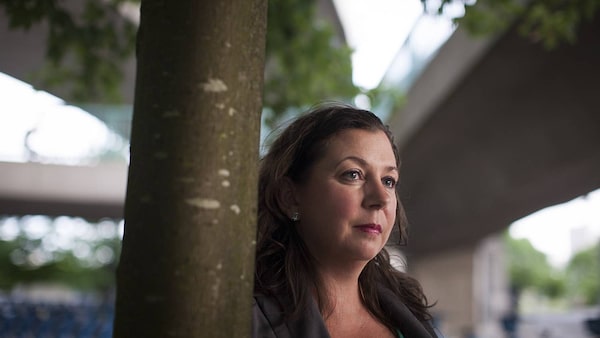
Angela Wright, who is a stroke survivor, is photographed in Vancouver, British Columbia, Monday, June 5, 2017.Rafal Gerszak/The Globe and Mail
When Angela Wright was 38 years old, she experienced the worst headache she ever had. She didn't realize it at the time, but she was having a hemorrhagic stroke, which occurs when a blood vessel ruptures, causing bleeding in or around the brain.
Dismissing it as a headache, she did not go to the hospital until her friend noticed her glasses had fallen onto her lap and her left ear was two inches lower because the muscles in her scalp had let go.
Ms. Wright is one of a growing number of young Canadians who have experienced stroke and faced barriers in rehabilitation. And patients across all age groups are not receiving the continuing support they need, says a new report by Heart & Stroke.
Read more: Ontario mental-health services struggling to keep up with youth demand, report finds
"After the first couple of weeks when someone comes home from the hospital, family and friends, everybody is there bringing flowers – then everyone disappears," said Dr. Patrice Lindsay, a director at Heart & Stroke (formerly the Heart and Stroke Foundation of Canada). "The patient is left on their own to figure the health system out."
In the past decade, there has been a relative 11-per-cent increase in the number of stroke patients between the ages of 20 and 59 in Canada, said Dr. Lindsay, who suffered a stroke at the age of 38. There were a little more than 5,000 younger stroke patients in 2006 across Canada (not including Quebec). This number increased to more than 7,200 strokes by 2015, she said.
A stroke occurs when blood stops flowing to any part of the brain and it can happen at all ages – although 80 per cent of all strokes happen to those over 60. The interruption damages the surrounding brain cells, which cannot be repaired or replaced. Immediate response becomes vital as 1.9 million brain cells die every minute during a stroke. (A human has more than 86 billion brain cells.) Strokes can lead to paralysis, depression and muscle weakness, as well as death.
Warning signs of stroke include weakness and droopiness in the face, arm or leg; trouble speaking or understanding; sudden vision problems; a severe and unusual headache; and a sudden loss of balance, said Dr. Rick Swartz, a key expert for the report.
"There are barriers in recognition. Individuals, family members and community members may not recognize symptoms of a stroke in a young adult," Dr. Swartz said. "I've seen a couple of cases with young adults having a stroke in a bar and everybody assumed they're drunk when they're not speaking well."
Stroke in young adults can be caused by heart problems and typical vascular risk factors such as high blood pressure, diabetes, smoking and unhealthy lifestyles. But one-third of stroke cases in young adults do not have a known cause, the report stated.
Dr. Lindsay said the reasons for the increase in strokes in younger people include access to more processed food, fast-paced but sedentary lifestyles and a rise in obesity in young children leading to risk factors for young adults.
Because of increased awareness of the signs of stroke and improvements in early stroke management, 80 per cent of people now survive a stroke – half of whom need help with daily activities, according to the report. More than 40 per cent of stroke patients are left with a disability that requires intense rehabilitation and community support.
Though she was paralyzed on both sides of her body, Ms. Wright managed to regain all mobility over time with extensive rehabilitation. The process wasn't easy, she said, as she was often provided with services geared to elderly patients. After evaluations at the hospital, Ms. Wright said she often easily completed a checklist focused on issues older patients typically face, such as swallowing.
"The tools that health professionals have at their disposal are meant for the senior population and the challenges they might have. They're not meant for someone in their 30s who is very active and leading a professional career," Ms. Wright said. "For things that were important to me like being able to sign my name again, there really wasn't anything they could do to help me – five years later and I still can't really write properly."
Young patients aren't the only group of stroke survivors that lack support, according to the report. More than 400,000 Canadians are living with the effects of stroke. This number will double in the next 20 years, posing a major challenge to the health-care system, the report said.
It found that of the stroke patients who leave inpatient acute hospital care, only about 16 per cent get into hospital-level rehabilitation immediately and only 19 per cent within the first month after leaving hospital.
"People have a perception that when you have a stroke and survive it, then you're fine and don't need a lot of help – but that's not true," Dr. Lindsay said. Health systems, communities and families all have a critical role to play in supporting the recovery of stroke patients, she added.